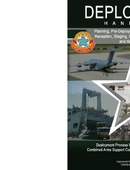
The Center for Army Lessons Learned leads the Army Lessons Learned Program and delivers timely and relevant information to resolve gaps, enhance readiness, and inform modernization.

Downloads: 223
Hits: 223
This handbook offers best practices and lessons learned to assist units in the deployment and redeployment process. It guides leaders and unit movement... read more
This handbook offers best practices and lessons learned to assist units in the deployment and redeployment process. It guides leaders and unit movement personnel through the detailed multi-facet process of deployment.
less

Downloads: 184
Hits: 184
This publication will provide the foundational knowledge needed to become data literate. Commanders and staff will learn about the different types of data,... read more
This publication will provide the foundational knowledge needed to become data literate. Commanders and staff will learn about the different types of data, methods for collecting and analyzing it, and how to apply data to improve operations. The goal of this publication is to foster data literacy and develop a foundation to interpret data, draw meaningful conclusions, and apply them to real-world challenges, making you a more effective leader, Soldier, and asset to the U.S. Army.
less

Downloads: 157
Hits: 157
This seven-page article provides best practices and lessons learned for units responding to emergency management scenarios. Specifically, it summarizes the... read more
This seven-page article provides best practices and lessons learned for units responding to emergency management scenarios. Specifically, it summarizes the North Carolina National Guard's Defense Support to Civil Authorities (DSCA) efforts during Hurricane Helene, notably creating an Incident Awareness and Assessment Cell (IAAC) to better identify emergency management requirements and allocate resources to disaster response organizations. It describes, in detail. the IAAC's formation, composition, key functions and products/tools developed that helped the North Carolina National Guard leverage established military processes, like the targeting working group and D3A methodology, to better respond during a DSCA mission.
less

Downloads: 251
Hits: 251
Sustaining military operations across an island chain presents complex logistical challenges that demand a reimagining of traditional echeloned sustainment... read more
Sustaining military operations across an island chain presents complex logistical challenges that demand a reimagining of traditional echeloned sustainment methods. Unlike overland campaigns, where supply lines are continuous and structured, island chain operations require overcoming vast distances, water barriers, and infrastructure limitations. At the Brigade Combat Team level, the Brigade Support Battalion must extend its planning horizons, integrate joint assets, and build redundancy into sustainment operations to ensure a resilient supply chain. Effective sustainment hinges on strategic prioritization of resources, coordination with maneuver planners, and adaptability of transportation constraints and unpredictable weather. Integrating into and managing a joint distribution network requires meticulous planning, risk mitigation, and flexible resupply solutions such as aerial and maritime deliveries. By leveraging joint capabilities and contingency planning, sustainers can maintain operations readiness and ensure maneuver forces remain supplied and combat effective in this dynamic and resource constrained battlespace.
less

Downloads: 258
Hits: 258
The Leader's Guide to Equipment Fielding examines and explains the modernization phase processes and roles across multiple echelons so that all entities... read more
The Leader's Guide to Equipment Fielding examines and explains the modernization phase processes and roles across multiple echelons so that all entities involved in the process can visualize the linkages across echelons that enable success. While primarily focusing on clarity of process and highlighting best practices in divesting old equipment and fielding new equipment, the guide also discusses the subsequent training phase planning and preparation milestones that occur during the modernization phase.
less

Downloads: 209
Hits: 209
As combat operations are successful, the rear area of the division will extend in depth, it will include previously contested population centers. The... read more
As combat operations are successful, the rear area of the division will extend in depth, it will include previously contested population centers. The division command must then have the means to address similar threats to friendly forces and stability. To meet these stability operations tasks, the civil affairs task force (CATF) is a way for a division to support rear operations during the offense.
less







